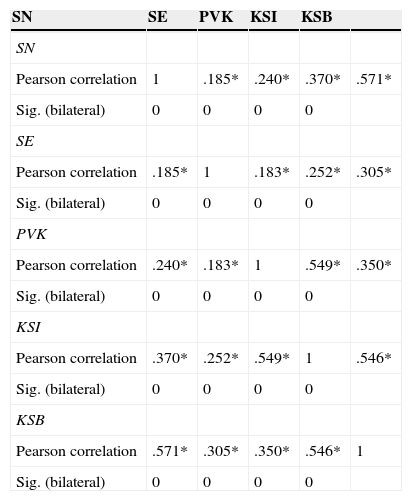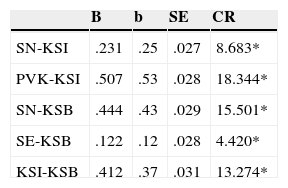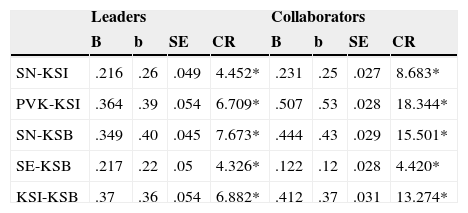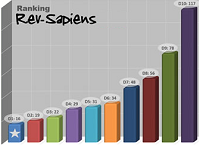The objective of this research was to evaluate the relationship of subjective norms, self-efficacy and perceived value of knowledge on the knowledge sharing intention and behavior in leaders and collaborators in organizations. Data were obtained from 1027 participants, 23.1% leaders and 76.9% collaborators. All the hypotheses were consistent with the data. A model of the relationship between variables was proposed. This study aims to contribute to the understanding of human factors involved in the behavioral approach to knowledge management.
El objetivo de esta investigación es evaluar la relación de normas subjetivas, autoeficacia y valor percibido del conocimiento con la intención y la conducta de compartir conocimiento en líderes y colaboradores en organizaciones. Los datos se obtuvieron de 1027 participantes, el 23.1% líderes y el 76.9% colaboradores. Todas las hipótesis fueron consistentes con los datos. Se propuso un modelo sobre la relación entre las variables. Esta investigación contribuye a comprender los factores humanos en el enfoque conductual de la gestión del conocimiento.
A constant concern of researchers, consultants and leaders has been to identify facilitators of knowledge sharing in organizations. Knowledge sharing is studied within the framework of the behavioral approach of knowledge management, which is committed with the role of people on the creation, organization, distribution and use of knowledge in organizations. According to Lin (2014), knowledge management incorporates the processes of generating, accessing, facilitating, integrating, embedding, applying, transferring and protecting knowledge. Helmstadter (2003) defined knowledge sharing as voluntary interactions between human actors whose raw material is knowledge. This behavior is not automatic but highly dependent on human variables (Scarbrough & Carter, 2000). What people share are their competences, experiences, expertise, values, contextual information and insights, in order to create institutional frameworks for evaluating and incorporating new experiences and information (Medina & Castañeda, 2010; Kim & Lee, 2005). Knowledge sharing is an action of people, not of information systems.
Despite the great research interest involved in knowledge sharing, there are still few studies that link this behavior with psychosocial variables (Castañeda, 2002; Castañeda & Toulson, 2013; Duarte & Castañeda, 2013; Tormo & Osca, 2011; Steward, 2008; Wang & Noe, 2010), and scarce research in Latin America (Castañeda, 2015; Delgado & Castañeda, 2011; Villamizar & Castañeda, 2014). The influence of human variables on knowledge sharing has been widely ignored (Cho, Li, & Su, 2007). This research aimed to evaluate the influence of subjective norms, self-efficacy and perceived value of knowledge on the knowledge sharing intention and behavior in a sample of leaders and collaborators.
Psychosocial variables and knowledge sharingAccording to the reasoned action theory (Fishbein & Ajzen, 1975; Ajzen, 1991), one of the powerful determinants of human behavior is subjective norms (SN); behavior is guided by beliefs about the normative expectations of people who are significant to the individual and the motivation he or she has to comply. At the organizational level, some studies have found influence of SN on the knowledge sharing intention (Bock & Kim, 2002; Bock, Zmud,Kim & Lee, 2005; Castaneda, 2010; Lin & Lee, 2004; Ryu, Ho & Han, 2003; Ho, Ting, Bau & Wai, 2011; Young, 2014; Zhang & Ng, 2013), and some on the influence of SN on the knowledge sharing behavior (Bock & Kim, 2002; Castaneda, 2010; Lin & Lee, 2004; Liu, Ma, Ho & Liu, 2013). Based on these studies the following two hypotheses are stated:
Hypothesis 1. Subjective norms influence the knowledge sharing intention.
Hypothesis 2. Subjective norms influence the knowledge sharing behavior.
Another explanatory variable of behavior is self-efficacy (SE), a concept developed by Bandura (1977, 1997), who defined it as the beliefs that an individual has about his / her own abilities to organize and execute the actions required, in order to produce the expected results. SE beliefs influence people's way of thinking, feeling and acting, and, therefore their accomplishments (Bandura, 2000). SE is critical in determining what individuals do with their knowledge (Anyster & Goodman, 2006).
There is some research linking SE with the knowledge sharing behavior, such as the study carried out by Cabrera, Collins and Salgado (2006), who found that a variable that influenced knowledge sharing behavior in large multinationals was SE. Tamjidyamcholo, Baba, Tamjid and Gholipour (2013) did not find any connection between SE and the knowledge sharing intention. Lu and Leung (2004) found a direct relationship between SE and knowledge sharing. Other studies that have linked self-efficacy and knowledge sharing behavior are the one conducted by Endres, Chowdhury and Alam (2007), specifically with tacit knowledge, the study led by Wang and Lai (2006) in virtual communities and the research guided by Teh, Chong and Young (2010) on internet SE. From the above statements the following hypothesis is proposed:
Hypothesis 3. Self-efficacy influences the knowledge sharing behavior.
A new concept in the field of knowledge management is called perceived value of knowledge (PVK), introduced by Ford and Staples (2006), defined as the worth an individual assigns to his or her own knowledge. These authors found that the PVK is directly related to the intention of knowledge sharing when the sharer does not lose, partially or totally, the value of a particular knowledge sharing it. PVK implies high communication and low protection of knowledge (Ford & Staples, 2010). In contrast, if knowledge is regarded as unique or singular, then the individual may perceive that while sharing it, this knowledge might lose value. In this case, a person will not have the intention to share it. According to data, the more knowledge is regarded as unique, the lower the probability of sharing it. The authors concluded that the singularity (uniqueness) dimension of knowledge is not part of the concept of PVK. Given its novelty, the authors of the construct recommend studying it in different cultures, suggestion that is followed in this study. There were no additional studies in the ISI web of science on the relationship between PVK and knowledge sharing intention. From the above statements the following hypothesis is formulated:
Hypothesis 4. The perceived value of knowledge influences the intention of knowledge sharing.
According to the reasoned action theory (Fishbein & Ajzen, 1975), the closest determinant of behavior is intention, which is the cognitive representation of the disposition of an individual to perform a behavior (Ajzen, 1991). Intention and behavior are different aspects of a functional relation separated in time (Bandura, 2001). There are some studies that have found a link between knowledge sharing intention and knowledge sharing behavior (Liu, Ma, Ho & Liu, 2013; Thakadu, Irani & Telg, 2013); therefore, the following hypothesis is stated:
Hypothesis 5. The knowledge sharing intention influences the knowledge sharing behavior.
In the academic literature it has been shown the relevant role of leaders as facilitators of knowledge creation and exchange (Collins & Smith, 2006; Nonaka & Toyama, 2005; Wicramasinghe & Widyaratne, 2012), as well of the importance of the relation leader-collaborators to promote knowledge sharing (Hassanzadeh, 2014); however, little research has been conducted on the differences between leaders and collaborators in relation to knowledge sharing intention and behavior. In this study it is proposed that:
Hypothesis 6. There is a moderator role of the position level (PL), understood as being a leader or a collaborator, in the relationship between the variables subjective norms, self-efficacy, perceived value of knowledge and knowledge sharing intention and behavior. Figure 1 shows the research model.
MethodParticipantsParticipants were 1027 knowledge workers, 238 leaders (23.1%) and 789 collaborators (76.9%); 53.9% of them women and 43% men; 3.1% of participants did not reply the question of sex. The average age was 34.5 years and the mode was 30 years. 27% of participants were workers of public organizations and 73% workers of private organizations. A knowledge worker is a person who depends primarily on the acquisition, creation, transmission and application of knowledge in order to perform his/ her work (Kelloway & Barling, 2000). The sample was obtained from Colombian organizations in different sectors, mainly educational, financial and public, and from participants in a national conference on knowledge management hosted in Medellin.
InstrumentThe following scales were used in this research: subjective norms, self-efficacy, perceived value of knowledge, intention to share and knowledge sharing behavior of the instrument called psychosocial variables and organizational conditions associated to knowledge sharing (Castañeda, 2010). Each scale has four items. Each item has seven response options presented in a Likert scale. All items were used as part of the same questionnaire in a random order. The Winsteps software (version 3.65.0) and the Rasch model were used for the analysis of the instrument. The instrument, its scales and all the items, showed internal consistency and reliability. Reliability of the instrument using Cronbach's alpha was .93.
ProcedureThe paper questionnaire was applied in the organizations by a research assistant and in the precinct of a large knowledge management conference for leaders in Medellin where the author of this article was one of the lecturers. Participants were informed of the purpose of the research and their participation was voluntary. The average time of the application was 15minutes.
ResultsConsidering that the research data came from observable variables, a path analysis was used. This tool facilitated the evaluation of relationships between the variables and the sizes of the effects. All the proposed hypotheses received support from the data. The highest effect was found between PVK on KSI (μ = .53) followed by SN on KSB (β = .43). The Table 1 shows the correlation between the variables, and Table 2 shows effect sizes.
– Correlations between variables.
| SN | SE | PVK | KSI | KSB | |
|---|---|---|---|---|---|
| SN | |||||
| Pearson correlation | 1 | .185* | .240* | .370* | .571* |
| Sig. (bilateral) | 0 | 0 | 0 | 0 | |
| SE | |||||
| Pearson correlation | .185* | 1 | .183* | .252* | .305* |
| Sig. (bilateral) | 0 | 0 | 0 | 0 | |
| PVK | |||||
| Pearson correlation | .240* | .183* | 1 | .549* | .350* |
| Sig. (bilateral) | 0 | 0 | 0 | 0 | |
| KSI | |||||
| Pearson correlation | .370* | .252* | .549* | 1 | .546* |
| Sig. (bilateral) | 0 | 0 | 0 | 0 | |
| KSB | |||||
| Pearson correlation | .571* | .305* | .350* | .546* | 1 |
| Sig. (bilateral) | 0 | 0 | 0 | 0 |
*All correlations between the research variables were significant, at 0.01. The highest correlation was between subjective norms and knowledge sharing behavior. The second highest correlation was between perceived value of knowledge and knowledge sharing intention.
According to the analysis, there are direct and indirect effects between the variables of the study, which are presented in Table 3. The strongest direct effect on KSB was from SN followed by KSI. The indirect effects are low.
Figure 2 presents the path diagram of the proposed model. Upon reviewing the adjustment indicators of the model, it was found that the CFI was .894, the GFI was .945 and the RMSEA was .09, which are considered as appropriate values (Hair, Black, Babin & Anderson, 2010).
Moderation analysisThe research sample was divided into two: leaders (238) and collaborators (789). Multigroup analysis was used to test the model en each sample and the results are presented in Table 4. There is a moderator effect in the relationship between PVK and KSI. In the leaders group the size of the effect was .39, while the effect was higher in the group of collaborators (.53), both of them statistically significant. The relationship between SE and KSB was the opposite. The highest effect was found in the leaders group (.22), while the effect in the collaborators group was .12, both statistically significant. In the same direction, the effect in the relationship SN and KSB in leaders was .40 while this effect in collaborators was .26.
– Moderation analysis.
| Leaders | Collaborators | |||||||
|---|---|---|---|---|---|---|---|---|
| B | b | SE | CR | B | b | SE | CR | |
| SN-KSI | .216 | .26 | .049 | 4.452* | .231 | .25 | .027 | 8.683* |
| PVK-KSI | .364 | .39 | .054 | 6.709* | .507 | .53 | .028 | 18.344* |
| SN-KSB | .349 | .40 | .045 | 7.673* | .444 | .43 | .029 | 15.501* |
| SE-KSB | .217 | .22 | .05 | 4.326* | .122 | .12 | .028 | 4.420* |
| KSI-KSB | .37 | .36 | .054 | 6.882* | .412 | .37 | .031 | 13.274* |
*p < .001.
In leaders, the highest total effect on KSB was from SN followed by KSI. In relation to KSI, in leaders the highest total effect was from PVK. The indirect effects are low.
In collaborators —as with leaders—, the highest total effect on KSB was from SN followed by KSI. In relation to KSI; the highest total effect in collaborators was from PVK as it occurs in leaders; however, the size of PVK in leaders on KSI was .386, while in collaborators the size of this effect was .53, higher than in leaders. Table 5
DiscussionThe objective of this research was to evaluate the influence of subjective norms and perceived value of knowledge on the knowledge sharing intention and the influence of subjective norms, self-efficacy and the knowledge sharing intention on the knowledge sharing behavior in organizations.
Consistent with the principles proposed by the reasoned action theory, support was found in data for the relationship between subjective norms and knowledge sharing intention as stated in Hypothesis 1. This finding was consistent with the study by Ryu, Ho and Han (2003), who found that subjective rules were the strongest influencing variable on the intention of knowledge sharing. In turn, Lin and Lee (2004) and Bock, Zmud,Kim and Lee (2005) found that subjective norms positively influenced the intention to share knowledge. In this research, SN was not the best predictor of KSI but PVK.
Hypothesis 2, which proposed that subjective norms influence the knowledge sharing behavior, was consistent with the data. The findings match those of Bock, Zmud,Kim and Lee (2005). It can be concluded that the pressure to share knowledge coming from meaningful people in the organization affects workers’ behavior. In this research, SN was the best predictor of KSB in leaders and collaborators.
On the other hand, hypothesis 3, which stated that selfefficacy influences the knowledge sharing behavior, was supported by results in leaders and collaborators. The findings are consistent with findings from other studies (Endres, Endres, Chowdhury & Alam, 2007; Lu & Leung, 2004; Wang & Lai, 2006). These results lead to the conclusion that there is a direct relationship between self-efficacy and knowledge sharing behavior.
Moreover, Krueger and Dickson (1993) found that efficacy beliefs influence individuals to focus on opportunities or impediments in the context. This means that there is a relationship between self-efficacy and environmental perceptions. People with high self-efficacy focus on opportunities and minimize the value of obstacles, which enables them to exercise control in an environment with limited opportunities (Bandura, 2012). Thus, it is of interest for further research to evaluate the role of self-efficacy in the perception of organizational conditions for knowledge sharing. It is possible that people with high selfefficacy to share knowledge perceive the same organizational conditions as opportunities, whereas those with low self-efficacy perceive them as threats.
Hypothesis 4, which stated that the perceived value of knowledge influences the intention to share knowledge, received support from the data. This finding is consistent with Ford and Staples's research (2006), proponents of that concept. It is worth mentioning that the relationship between PVK and knowledge intention was higher in collaborators than in leaders. A possible explanation to be studied in future research is that the role of a collaborator implies sharing useful knowledge with others permanently, while the role of a leader involves using valuable knowledge principally to make decisions.
In relation to hypothesis 5, there a relation was found between the knowledge sharing intention and behavior from the data. This relationship was valid in this research — both in leaders and collaborators. However, the relationship was less strong than with SN and PVK.
As a contribution of this research, the exploration and development of a new concept that integrates the notions of perceived value of knowledge (Ford & Staples, 2006) and knowledge sharing behavior is recommended. The name proposed for that new concept is perceived value of knowledge sharing. It would keep the dimension of usefulness found by Ford and Staples (2006); however, in contrast to the issues raised by these authors, it would include the dimension of singularity. It is possible that the latter is not part of the concept of perceived value of knowledge, but it may be relevant as a dimension of the perceived value of knowledge sharing. In other words, the perception of knowledge as unique may be a component of how valuable it is to share or not to share knowledge.
There are at least two lessons for practitioners. The first one is that knowledge sharing behavior can be facilitated. For example, some actions should be oriented to strengthening knowledge sharing self-efficacy. When a worker is competent in some skill, but he or she believes that they are not competent to share knowledge associated to that skill, then it is possible that it never occurs. In this case, the organization may lose opportunities of improvements based on knowledge. The second lesson is that leaders have a relevant role in facilitating knowledge sharing. If leaders share knowledge, they may contribute to the strengthening of the subjective norm associated to knowledge sharing. It is recommended for future research to continue with this line of incorporating psychology as a discipline in the study of knowledge sharing intention and behavior, as it has much to contribute to their explanation. Knowledge management is no longer just a technology subject, but it has become an interdisciplinary topic where understanding the behavior of knowledge sharing is fundamental in order to create and apply valuable knowledge. Table 6














